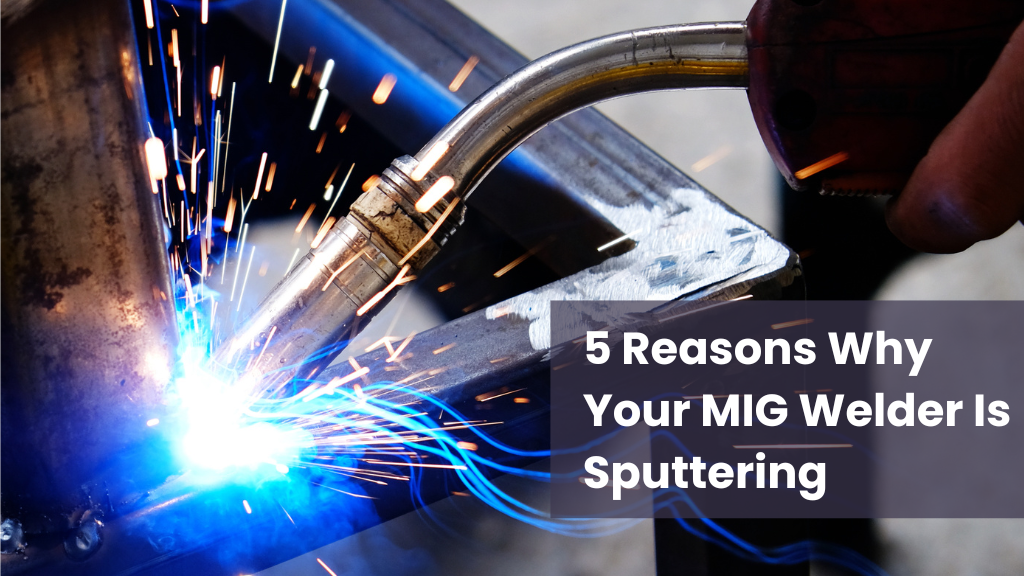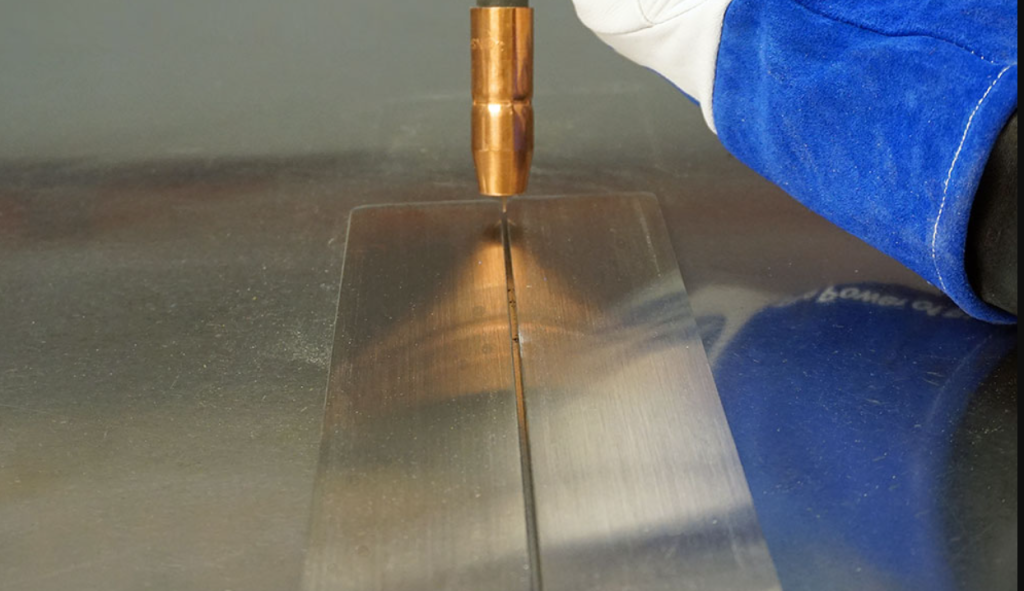This is due to the fact that when the power source senses a reduced current flowing through the arc, it immediately sends a surge in voltage to address the issue, causing the popping and sputtering which cause the poor and inconsistent weld quality to result.

30 Models Considered
200 Hours of Research
48 Experts Interviewed
76 Reviews Analyzed
In MIG welding, sputtering is inevitable. When metals are made to melt and are then joined with each other with the aid of a torch that creates an intense hot arc, then the metals spill out their hot contents all over the place as a result of the heat.
What more can one accept than metals scattering around in hot droplets?
It is also important to note that this does not mean that half of the filler metal is destined to go scatter everywhere. Do you experience this problem? Is your MIG welding not smooth because of sputtering?
This blog lists some of the reasons that may be causing this. Once you find your fault, you can take care of it and you are all set.
Top 5 Reasons Your MIG Welder Might Be Sputtering
It is imperative to keep in mind that there are many reasons why your MIG welder may be sputtering, but these are the 5 most common ones. Therefore, if you are looking for the cause and fixing your problem, it is imperative to start with these 5 causes.
Excessive Resistance/ Poor Conductivity Along the Circuit
The possibility exists that the cause of your MIG welder sputtering or creating erratic arcs is caused by excessive resistance along the circuit or a lack of conductivity along the circuit, depending on the situation.
Due to the fact that excessive circuit resistance reduces the amount of current flowing from the MIG welder gun to the welding arc, excessive circuit resistance will severely impact the welding arc.
As a result of the restricted current flow, the MIG welder will try to overcome this issue by sending a voltage surge to the arc as soon as the power source detects a substantial reduction in current flow to the arc.
It is common for the MIG welder to pop and sputter during this process due to the increased voltage. This affects the quality of the arc as well as the overall welding process.
The conductivity of a cable may also be affected by a variety of mechanical factors, such as stranding of copper that is damaged within the cable, the use of a diffuser that is too small for the intended application, or worn contact tips.
Dirty Wire or Components

You should be considering checking your welding materials and components before you begin the welding process in order to ensure that they are clean and free from contaminants. Clean components and wire are essential to smooth, efficient welding.
It is quite common for rust, paint, dust, grease, and other substances to be able to cover the wire, metal, or MIG welder components.
Due to the high temperatures required to conduct welding, if these contaminants are present during the welding process, they will likely burn, bubble, or outgas as a result of the welding process.
Besides the fact that your MIG welder is likely to sputter, it is also very likely that your welder gun and components will be damaged as a result.
You will need to replace or repair them in the future. As a result, every foreign contaminant will mix in with the puddle and create a weak joint that will eventually fail.
Due to the importance of keeping your equipment and materials clean and shiny in order to avoid damage and to avoid joints that do not function correctly, it is essential.
Low Gas Flow
Having a low gas flow rate is another common cause of sputtering in MIG welders. Unless you have proper gas flow, you cannot hope to make an effective weld that will last for some time.
Shielding gas protects the liquefied puddle from physical and atmospheric contaminants, both of which are harmful to it. It is possible for the MIG welder to sputter when there are pinholes in the weld without this protection.

An indication that your system might be experiencing low gas flow, or even being supplied with the wrong type of gas, would be charring or sugar coating on the weld face, porosity on the surface, or a small pinhole in the gas line.
In welding, it is very significant to have a proper flow of gas. If you have a low flow, you will end up having sputtering on the MIG welding machine.
However, if the flow is too high, you will end up with spattering, which is a messy and common welding problem. You need to make sure you have the correct shielding gas and flow rate before you can start preventing these issues.
Worn Contact Tips and Liners
There is also a need to keep in mind that, similar to other types of equipment, if parts of your MIG welder are worn out, it will likely cause you to sputter during the welding process, as is the case with other types of equipment. A contact tip and a liner are two of the most commonly worn-out components of a contact gun.
There is a need to maintain the condition of the welding contact tip to ensure the wire receives the welding current in a precise and controlled manner.
Therefore, if the contact tip becomes worn over time, the wire will not be able to pass through the bore and create the perfect arc necessary for quality welding.
A MIG welding liner is a crucial component because it helps direct the wire from the wire feeder to the contact tip. Your MIG welder will suffer a severe compromise if the liners on the gun become worn.
The MIG welder will sputter and produce a poor arc if the liners are worn as they prevent the wire from reaching the contact tip undisturbed or if the liners are worn.
Welding gun angle is important
A large amount of spatter is a result of the angle at which the MIG welding gun is held. Extending beyond a 15-degree angle will result in spattering. Slightly steep positions are also prone to high levels of spattering.

You should therefore learn the correct way of holding the welding gun in order to avoid the problem you may be experiencing even though everything else is perfect in your welding setup.
How Do I Stop My MIG Welder from Sputtering?
It would be best to troubleshoot the four common causes of the MIG welder sputtering in the first place in order to see if this fixes the issue. It is also important to take preventive measures in order to make sure your MIG welder functions properly at all times to minimize the chances of the issue reoccurring.
Troubleshooting the Top 4 Reasons a MIG Welder Is Sputtering
|
Issue |
Common Resolutions |
|---|---|
|
Insufficient conductivity/excessive resistance along the circuit |
It is essential that you check the three main connections of the gun -at its power source and its plug, at its power cable, neck, diffuser, contact tip, and welding wire-at the work lead, welding table, and power source-at the work lead. If the gun or the wiring is damaged, remove or replace it. Consider using compression fittings if the gun or wiring is damaged. |
|
Having dirty wires or components |
You must clean and inspect the components of your MIG welder gun to eliminate any potentially harmful contaminants. You should dispose of any compromise wire. If welding on metal, you should ensure that it is clean and shining. It is best to use a chemical cleaner that removes oxidation. |
|
Low Gas Flow |
Ensure that the orifice in the outlet fitting is not blocked or blocked off. Determine if there is a leak in the pipe joints, diaphragm vents, or the welder’s gas connection. Be sure to first check your flow gauge regulator in order to determine how your gas flow should be adjusted. |
|
Worn Contact Tips and Liners |
Generally speaking, the liner is one of the cheapest components of the MIG welding process, which means that if you notice that the liner is worn, you should replace it as soon as possible. If the contact tip bore shows signs of erosion, you need to replace it. Sputtering, as well as other issues such as wire placement offset, erratic arcs, and irregular or missed welds, will continue if you do not do so. |
Quick tips to keep the spattering nuisance at bay
1. Make sure you learn well!
You are able to turn welding into an art if you are diligent about learning the techniques. If you fail to be thorough in your preparations, you will find yourself doing something uncomfortable.
Be sure to observe other welders, watch instructional videos, and most importantly, practice. If you follow the right procedures, you can control scattering.
2. There is an anti-spatter spray that can help!
A chemical composition that’s oil-based, anti-spatter spray, when sprayed on metal or glass, makes spatter balls stay loose and are easy to chip off.
3. Mill scales should be kept out of the way!
During MIG welding, mill scales will cause spattering if they are present, so make sure to clean them off before you start welding. You can grind or chip them away.
4. Pulsed MIG welding is worth a try!
With pulsed MIG welding, you can weld with more precision and a lower temperature input. This will result in spatter-free welding with good penetration and consistent bead profiles.
5. Use a hammer or chisel if you have one!
It is easy to remove stubborn spatter balls stuck to metal surfaces or other surfaces with a spatter hammer or chisel. A slight push will allow the solid drops to be removed.
6. Using a grinder is also an option!
Rather than chipping away the spatter balls, grinders grind them until they disappear. As opposed to using a chisel or hammer to clear the area, a grinder machine will work on its own once it is started. Just keep it on top of the surface and it will do the rest for you.
Final thoughts
There will always be some degree of scattering that occurs while welding, no matter how hard you try. But, if it becomes too much and becomes a hindrance to your welding process, it is up to you to consider the reason behind it. You can also work towards its removal.
This blog was clearly written with the purpose of making you familiar with the common flaws that lead to over spattering when MIG welding. I hope it has been helpful to you.